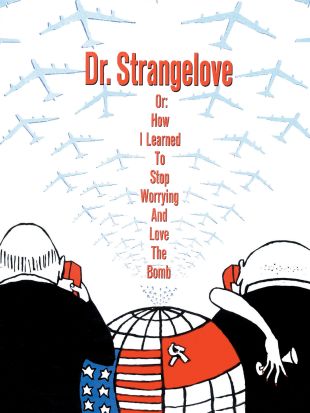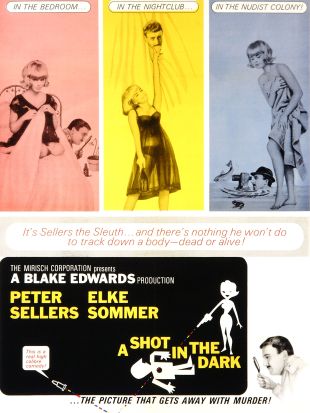One of the greatest comic talents of his generation, Peter Sellers had an exceptional gift for losing himself in a character -- so much so that, beyond his remarkable skill as a performer and his fondness for the humor of the absurd, it's difficult to draw a connection between many of his best performances. While his fondness for playing multiple roles in the same film may have seemed like a stunt coming from many other actors, Sellers had the ability to make each character he played seem distinct and different, and while he was known and loved as a funnyman, only in a handful of roles was he able to explore the full range of his gifts, which suggested he could have had just as strong a career as a dramatic actor.
Born Richard Henry Sellers on September 8, 1925, Sellers was nicknamed "Peter" by his parents, Bill and Agnes Sellers, in memory of his brother, who was a stillbirth. Bill and Agnes made their living as performers on the British vaudeville circuit, and Sellers made his first appearance on-stage only two days after his birth, when his father brought out his infant son during an encore. As a child, Sellers studied dance at the behest of his parents when not occupied with his studies at St. Aloysius' Boarding and Day School for Boys. Sellers also developed a knack for music, and in his teens began playing drums with local dance bands. Shortly after his 18th birthday, Sellers joined the Royal Air Force, and became part of a troupe of entertainers who performed at RAF camps both in England and abroad. During his time in the service, Sellers met fellow comedians Spike Milligan, Harry Secombe, and Michael Bentine; after the war, they found work as performers with the British Broadcasting Corporation, and Sellers hoped to follow suit. After several failed auditions, Sellers struck upon the idea of calling Roy Speer, a BBC producer, posing as one of the network's top actors. Sellers gave Sellers an enthusiastic recommendation, and Speer gave him a spot on the radio series Show Time.
After he signed on with the BBC, Sellers became reacquainted with Milligan, Secombe, and Bentine, and together they comprised the cast of The Goon Show, which upon its debut in 1949 became one of Great Britain's most popular radio shows; the absurd and often surreal humor of the Goons would prove to be the first glimmer of the British Comedy Movement of the '60s and '70s, paving the way for Beyond the Fringe and Monty Python's Flying Circus. The Goon Show provided Sellers with his entry into film acting, as he appeared in several short comedies alongside Milligan and Secombe, as well as the feature film Down Among the Z Men (aka The Goon Movie). Sellers also married for the first time during the height of Goon-mania, wedding Anne Howe in the fall of 1951. Sellers won his first significant non-Goon screen role in 1955, with the classic Alec Guinness comedy The Ladykillers, but his first international hit would have to wait until 1958, when he appeared in George Pal's big-budget musical Tom Thumb. In 1959, Sellers appeared in the satiric comedy I'm All Right, Jack, which earned him Best Actor honors from the British Film Academy; the same year, Sellers enjoyed a major international success with The Mouse That Roared, in which he played three different roles (one of them a woman). While a bona-fide international comedy star, Sellers had a hard time finding roles that made the most of his talents, and it wasn't until after a handful of unremarkable features that he received a pair of roles that allowed him to truly shine. In 1961, Sellers starred as an Indian physician in The Millionairess opposite Sophia Loren, based on a play by George Bernard Shaw (Sellers and Loren would also record a comic song together, "Goodness Gracious Me," which was a hit single in Britain), and a year later Stanley Kubrick cast him as Claire Quilty in his controversial adaptation of Vladimir Nabokov's novel Lolita.
1964 would prove to be a very big year for Peter Sellers; he would marry actress Britt Ekland in February of that year (his marriage to Anne Howe ended in divorce in 1961), and he starred in four of his most memorable films: Dr. Strangelove, or How I Learned to Stop Worrying and Love the Bomb, which reunited him with Stanley Kubrick and gave him star turns in three different roles; The World of Henry Orient, a comedy which won a small but devoted cult following; The Pink Panther, in which Sellers gave his first performance as the bumbling French detective Inspector Clouseau, and that film's first sequel, A Shot in the Dark. Sellers, who was described by many who knew him as a workaholic, maintained a busy schedule over the next ten years, but while the quality of his own work was consistently strong, many of the films he appeared in were sadly undistinguished, with a handful of exceptions, among them I Love You, Alice B. Toklas, The Wrong Box, and The Optimists. Sellers' appeal at the box office began to wane, and his love life took a beating as well -- he divorced Britt Ekland in 1968 and married Miranda Quarry in 1969, only to see that marriage end in 1971. But Sellers made a striking comeback in 1974 with The Return of the Pink Panther, in which he revisited his role as Inspector Clouseau. The film was a massive international hit, and Sellers would play Clouseau two more times, in The Pink Panther Strikes Again and The Revenge of the Pink Panther, though he became critical of the formulaic material in the films and would begin writing a script for a sixth Pink Panther film without the input of Blake Edwards, who had written and directed the other films in the series.
In 1977, Sellers took his fourth wife, actress Lynne Frederick, and he managed to rack up a few moderate box-office successes outside the Pink Panther series with Murder by Death and The Prisoner of Zenda. But in 1979, Sellers gave perhaps his greatest performance ever as Chance, a simpleton gardener whose babblings about plants are seen as deep metaphors by those around them, in a screen adaptation of Jerzy Kozinski's novel Being There -- a project Sellers had spent the better part of a decade trying to bring to the screen. The film won Sellers a Golden Globe award and a National Board of Review citation as Best Actor, while he also received an Academy Award nomination in the same category. While Being There seemed to point to better and more ambitious roles for Sellers, fate had other plans; the actor, who had a long history of heart trouble, died of a heart attack on July 24, 1980, not long after completing The Fiendish Plot of Dr. Fu Manchu, a disastrous comedy whose direction was taken over by Sellers midway through the shoot (though the original director received sole credit). Two years after his death, Peter Sellers would return to the screen in a final Pink Panther adventure, The Trail of the Pink Panther, which Blake Edwards assembled from outtakes and discarded scenes shot for the previous installments in the series.


/_derived_jpg_q90_310x470_m0/ThePinkPanther1964-PosterArt.jpg)